
The Gardens at Elm Bank, home of Massachusetts Horticultural Society, occupies 36 acres (15 ha) of Elm Bank Reservation, a 175-acre (71 ha) recreational area of woodlands, fields, and former estate property on the Charles River managed by the Massachusetts Department of Conservation and Recreation. The estate's entrance is located at 900 Washington Street, Wellesley, Massachusetts, United States, with the major portion of the grounds located in the neighboring town of Dover. In 1987, the entire site was added to the National Register of Historic Places as Elm Bank.
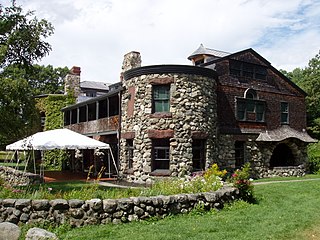
The Robert Treat Paine Estate, known as Stonehurst, is a country house set on 109 acres (44 ha) in Waltham, Massachusetts. It was designed for philanthropist Robert Treat Paine (1835-1910) in a collaboration between architect Henry Hobson Richardson and landscape architect Frederick Law Olmsted. It is located at 100 Robert Treat Paine Drive. Since 1974 the estate has been owned by the City of Waltham and its grounds kept as a public park, and is believed to be the only residential collaboration by Richardson and Olmsted that is open to the public.

This is a list of properties and districts in Massachusetts listed on the National Register of Historic Places. There are over 4,300 listings in the state, representing about 5% of all NRHP listings nationwide and the second-most of any U.S. state, behind only New York. Listings appear in all 14 Massachusetts counties.

Alewife Brook Parkway is a short parkway in Cambridge and Somerville, Massachusetts. It is listed on the National Register of Historic Places. It begins at Fresh Pond in Cambridge, and heads north on the east bank of Alewife Brook, crossing into West Somerville and ending at the Mystic River on the Medford town line, where it becomes Mystic Valley Parkway. The entire length of Alewife Brook Parkway is designated as part of Massachusetts Route 16 (Route 16), while the southernmost sections are also designated as part of Route 2 and U.S. Route 3 (US 3). It is managed by the Department of Conservation and Recreation with the Massachusetts Department of Transportation responsible for bridge maintenance.

Mystic Valley Parkway is a parkway in Arlington, Medford, Somerville, and Winchester, Massachusetts, United States. It is listed on the National Register of Historic Places, and forms part of Route 16.

The Neponset Valley Parkway is a historic parkway in southern Boston and Milton, Massachusetts, United States. It is a connecting parkway in the Greater Boston area's network, providing a connection between the Blue Hills Reservation, Neponset River Reservation, and the Stony Brook Reservation. The parkway was constructed between 1898 and 1929 with design assistance from Charles Eliot and the Olmsted Brothers. It was listed on the National Register of Historic Places in 2005.
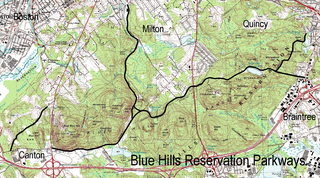
The Blue Hills Reservation Parkways are a network of historic parkways in and around the Blue Hills Reservation, a Massachusetts state park south of Boston, Massachusetts. It consists of six roadways that provide circulation within the park, and that join the park to two connecting parkways, the Blue Hills Parkway and the Furnace Brook Parkway. The roadway network was designed by Charles Eliot in the 1890s, except for Green Street, which was added to the network in the 1940s. The parkways were added to the National Register of Historic Places in 2003.

Whitman Park is a historic park near the center of the town of Whitman, Massachusetts. It is bounded by Maple Street and Park, Whitman, and Hayden Avenues. The park was established in 1880 by a gift of land from Augustus Whitman, whose family gave the town its name. The well-known Olmsted Brothers landscape firm was retained to design a public park on this land, which was implemented in 1900. This gave the park the basic layout of its paths, as well as its general appearance as a woodland park with open fields for passive recreation. Features that were part of the Olmsted design include a wading pool, concrete tennis court, bandstand, and a drinking fountain. The Olmsteds were retained again in 1931 to update the design, accounting for the addition in 1908 of the Civil War monument, and to deal with problematic drainage of water from the park's low-lying areas. The major intrusion on the Olmsted design has been the construction of a Little League ballfield in one corner.

Olmsted Subdivision Historic District is a historic district roughly bounded by New Ocean St/Paradise Road, Swampscott Avenue, Redington Street and Burrill Street in Swampscott, Massachusetts.
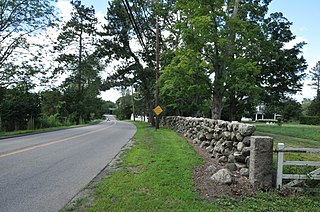
The Wellington Farm Historic District encompasses a historic farm property at 487—500 Wellesley Street in Weston, Massachusetts. Included in the 35-acre (14 ha) district are a main house built c. 1760, a barn complex with buildings dating from the 19th and 20th centuries, a modern greenhouse, and farm fields lined by stone walls. It is historically significant for its well-preserved buildings, and for its later transformation into a summer estate. It is also one of the town's few remaining working farms. The district was listed on the National Register of Historic Places in 1988.
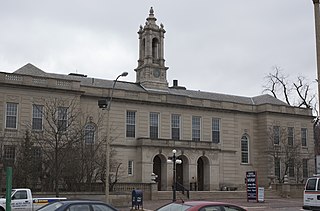
The Arlington Center Historic District includes the civic and commercial heart of Arlington, Massachusetts. It runs along the town's main commercial district, Massachusetts Avenue, from Jason Street to Franklin Street, and includes adjacent 19th- and early 20th-century residential areas roughly bounded by Jason Street, Pleasant Street, and Gray Street. The district was listed on the National Register of Historic Places in 1974.

The Middlesex Fells Reservoirs Historic District is a historic district roughly bounded by Pond St., Woodland Rd., I-93, and MA 28 in Stoneham and Medford, Massachusetts. It encompasses a portion of the Middlesex Fells Reservation, a state park managed by the Massachusetts Department of Conservation and Recreation (DCR). The principal features of the district are three reservoirs and their associated gate houses and pumping stations, which were developed by the Metropolitan District Commission starting in the late 19th century. The district was listed on the National Register of Historic Places in 1990.
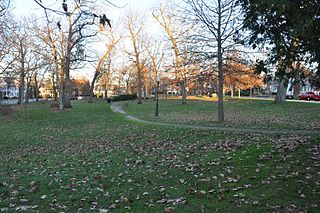
The Tyler Park Historic District encompasses a planned residential development in western Lowell, Massachusetts. The development was designed by Olmsted, Olmsted and Eliot, and is centered on Tyler Park; this area is the only Olmsted design in the city. It is roughly bounded by Princeton, Foster, and Pine Streets. Except for a few early houses that predate the subdivision, the area was built out between 1888 and 1936, and reflect the architectural styles popular in the period.

Blue Hills Parkway is a historic parkway that runs in a straight line from a crossing of the Neponset River, at the south border of Boston to the north edge of the Blue Hills Reservation in Milton, Massachusetts. It was built in 1893 to a design by the noted landscape architect, Charles Eliot, who is perhaps best known for the esplanades along the Charles River. The parkway is a connecting road between the Blue Hills Reservation and the Neponset River Reservation, and was listed on the National Register of Historic Places in 2003.
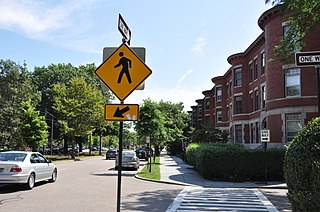
The Beacon Street Historic District is a historic district running most of the length of Beacon Street in Brookline, Massachusetts, roughly from Saint Mary's Road, near Kenmore Square, to Ayr Road near Cleveland Circle. It includes a small number of properties on adjacent streets, and was listed on the National Register of Historic Places in 1985.

Hammond Pond Parkway is a historic parkway in Chestnut Hill, Massachusetts. The road, built in 1932, extends 2 miles (3.2 km) from Hobart Road in Newton to Horace James Circle in Brookline, where it joins the West Roxbury Parkway. It was designed by Charles Eliot and the Olmsted Brothers to provide a parkway setting that provided access from Brookline, Newton, and the western portions of Boston to the southern parks of the Emerald Necklace. The parkway was listed on the National Register of Historic Places in 2004.

Stony Brook Reservation is a woodland park in Boston and Dedham, Massachusetts, a unit of the Metropolitan Park System of Greater Boston, part of the state park system of Massachusetts. It was established in 1894 as one of the five original reservations created by the Metropolitan Park Commission. The park is served by the Stony Brook Reservation Parkways, a road system that was entered into the National Register of Historic Places in 2006.
The Frederick Law Olmsted Summer Home, also known as Felsted, is a historic house in the town of Deer Isle, Maine. It is located on the west side of the same-named island, south of the village of Sunset. Designed by William Ralph Emerson and built in 1897, it was for one year the summer home of the famous landscape architect Frederick Law Olmsted in a bid to improve his failing mental health. Olmsted, then retired and severely affected by senility, was later committed McLean Hospital in Massachusetts, where he died in 1903. The house is a high-quality example of Shingle style architecture; it was listed on the National Register of Historic Places in 1976.

Cedar Brook Park is a 78-acre (32 ha) county park in the city of Plainfield in Union County, New Jersey. Featuring the Shakespeare Garden, it was listed on the National Register of Historic Places on June 25, 2007, for its significance in landscape architecture. The park was designed by the Olmsted Brothers of Brookline, Massachusetts from 1924 to 1930. A small portion of the park extends into the borough of South Plainfield in Middlesex County.
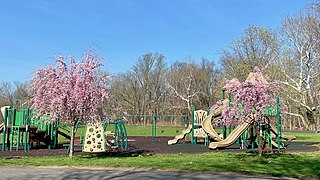
Green Brook Park is a 100-acre (40 ha) county park along the Green Brook, a tributary of the Raritan River, in the city of Plainfield in Union County, New Jersey. Designed by the Olmsted Brothers, it was added to the National Register of Historic Places on May 14, 2004, for its significance in landscape architecture. It extends into the borough of North Plainfield in Somerset County.





















